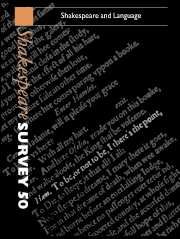Book contents
- Frontmatter
- Shakespeare’s Language and the Language of Shakespeare’s Time
- ‘I’ll plague thee for that word’: Language, Performance, and Communicable Disease
- The Language of the Spectator
- Marlowe’s Edward II: Penetrating Language in Shakespeare’s Richard II
- Hamlet’s Ear
- Secrecy and Gossip in Twelfth Night
- Shakespeare Rewriting Ovid: Olivia’s Interview with Viola and the Narcissus Myth
- ‘Voice Potential’: Language and Symbolic Capital in Othello
- Household Words: Macbeth and the Failure of Spectacle
- Erring and Straying Like Lost Sheep: The Winter’s Tale and The Comedy of Errors
- The ‘Shakespearian Gap’ in French
- Reading the Early Modern Text
- Shakespeare and the Metamorphosis of the Pentameter
- Rereading Illustrations of the English Stage
- Nietzsche’s Hamlet
- ‘Strange and woonderfull syghts’: The Tempest and the Discourses of Monstrosity
- Shakespeare Performances in England, 1996
- Professional Shakespeare Productions in the British Isles, January–December 1995
- 1 Critical Studies
- 2 Shakespeare’s Life, Times, and Stage
- 3 Editions and Textual Studies
- Books Received
- Index
Secrecy and Gossip in Twelfth Night
Published online by Cambridge University Press: 28 March 2007
- Frontmatter
- Shakespeare’s Language and the Language of Shakespeare’s Time
- ‘I’ll plague thee for that word’: Language, Performance, and Communicable Disease
- The Language of the Spectator
- Marlowe’s Edward II: Penetrating Language in Shakespeare’s Richard II
- Hamlet’s Ear
- Secrecy and Gossip in Twelfth Night
- Shakespeare Rewriting Ovid: Olivia’s Interview with Viola and the Narcissus Myth
- ‘Voice Potential’: Language and Symbolic Capital in Othello
- Household Words: Macbeth and the Failure of Spectacle
- Erring and Straying Like Lost Sheep: The Winter’s Tale and The Comedy of Errors
- The ‘Shakespearian Gap’ in French
- Reading the Early Modern Text
- Shakespeare and the Metamorphosis of the Pentameter
- Rereading Illustrations of the English Stage
- Nietzsche’s Hamlet
- ‘Strange and woonderfull syghts’: The Tempest and the Discourses of Monstrosity
- Shakespeare Performances in England, 1996
- Professional Shakespeare Productions in the British Isles, January–December 1995
- 1 Critical Studies
- 2 Shakespeare’s Life, Times, and Stage
- 3 Editions and Textual Studies
- Books Received
- Index
Summary
Renaissance secrecy is no longer quite as secret as it was. Art historians and iconologists have returned to the myths and emblems explored by Panofsky and Edgar Wind, and reassessed (often sceptically) their claims to hermetic wisdom. Thanks to Jonathan Goldberg and Richard Rambuss, we now have a better understanding of the early modern English secretary, and of how his pen could produce, in Lois Potter’s phrase, Secret Rites and Secret Writing. Not just in popular biographies of Marlowe and Shakespeare, but in such Foucauldian accounts of high culture as John Michael Archer’s Sovereignty and Intelligence, the world of Renaissance espionage is being analysed afresh. William W. E. Slights has written at useful length about conspiracy, fraud and censorship in middle–period Jonson. And, though the tide of Puttenham studies has now begun to ebb, students of Elizabethan England are still profiting from the work done by Daniel Javitch and Frank Whigham on what The Arte of English Poesie calls ‘false semblant’ or ‘the Courtly figure Allegoria’ –a line of enquiry which leads back to the civilized dissimulation advocated by Castiglione, but also to the politic ruthlessness of ‘1’ art machiavelien d’être secret’.
These investigations have not advanced in a state of mutual ignorance, but they have, inevitably, suffered from a degree of exclusive specialism. What interests me, on the other hand, is how different modes of concealment operated together. Certainly, I have found it impossible, in thinking about Twelfth Night, to separate iconography from secretarial inscription (as when Malvolio unpicks the Lucrece seal of silence on Maria's riddling letter), or to divorce Sebastian's intelligence-gathering, among 'the memorials and the things of fame' in Illyria, from that rhetorical discretion in him which is equally recommended in courtesy literature.
- Type
- Chapter
- Information
- Shakespeare Survey , pp. 65 - 80Publisher: Cambridge University PressPrint publication year: 1997
- 1
- Cited by



